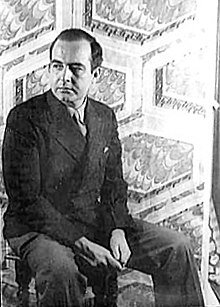| Piano Sonata | |
|---|---|
| by Samuel Barber | |
 The composer in 1944 | |
| Catalogue | Op. 26 |
| Genre | Classical |
| Form | Sonata |
| Composed | 1947–1949 |
| Duration | 20 minutes |
| Movements | 4 |
| Scoring | Solo piano |
| Premiere | |
| Date | December 9, 1949 |
| Location | Havana, Cuba |
| Performers | Vladimir Horowitz |
The Piano Sonata in E-flat minor, Op. 26, by the American composer Samuel Barber, was commissioned for the twenty-fifth anniversary of the League of Composers by American songwriters Irving Berlin and Richard Rodgers. Composed from 1947 to 1949, the sonata is in four movements. It was first performed by Vladimir Horowitz in December 1949 in Havana, Cuba, followed by performances in Washington, D.C. and New York City in January 1950. The sonata is regarded as a cornerstone of American piano literature and one of Barber's most significant achievements. Critics hailed it as a defining moment in mid-20th-century music, with The New York Times describing it as the "first sonata truly to come of age by an American composer of this period".
Barber began composing the work in September 1947, completing the first movement later that year. However, progress was slow due to his demanding schedule, which included preparations for his ballet Medea and Knoxville: Summer of 1915. A planned retreat to the American Academy in Rome to focus on the sonata proved unproductive, as Barber was distracted by the postwar social scene and his interactions with intellectuals, Vatican insiders, and Italian culture. Barber returned to the United States in 1948 and completed the second movement by mid-August. Initially, Barber envisioned a three-movement work, but after sharing his progress with Horowitz, the pianist suggested a four-movement structure with a "flashy last movement". This advice led Barber to compose a virtuosic four-voice fugue as a final movement.
Horowitz premiered the sonata in Havana, Cuba, on December 9, 1949. He followed this premiere with a private performance in New York in early January 1950 attended by prominent composers including Aaron Copland and Gian Carlo Menotti. The official U.S. premiere took place at Constitution Hall in Washington, D.C., later that month, followed by a performance at New York's Carnegie Hall. The sonata was met with immediate widespread acclaim, and has since been performed and recorded often.